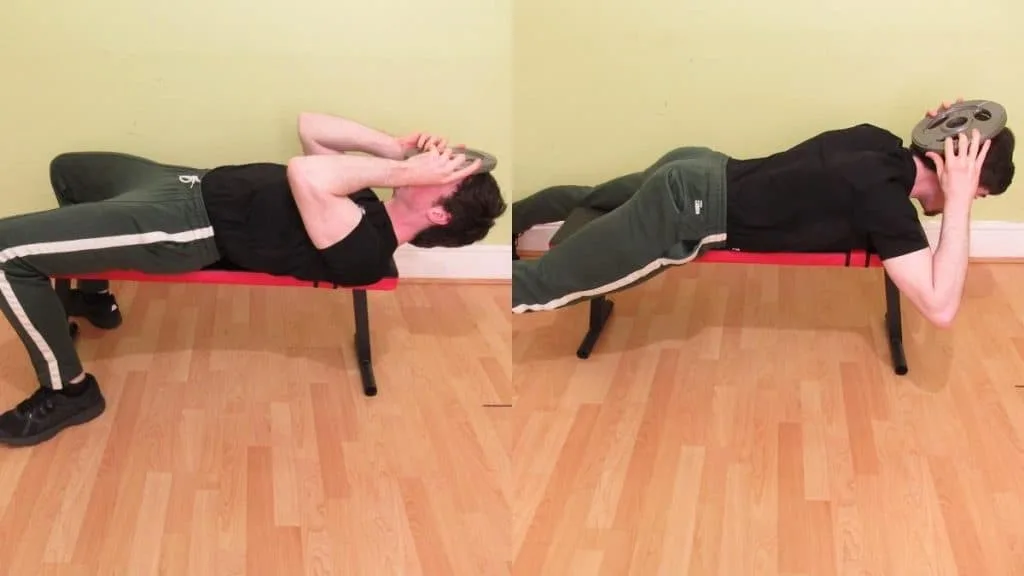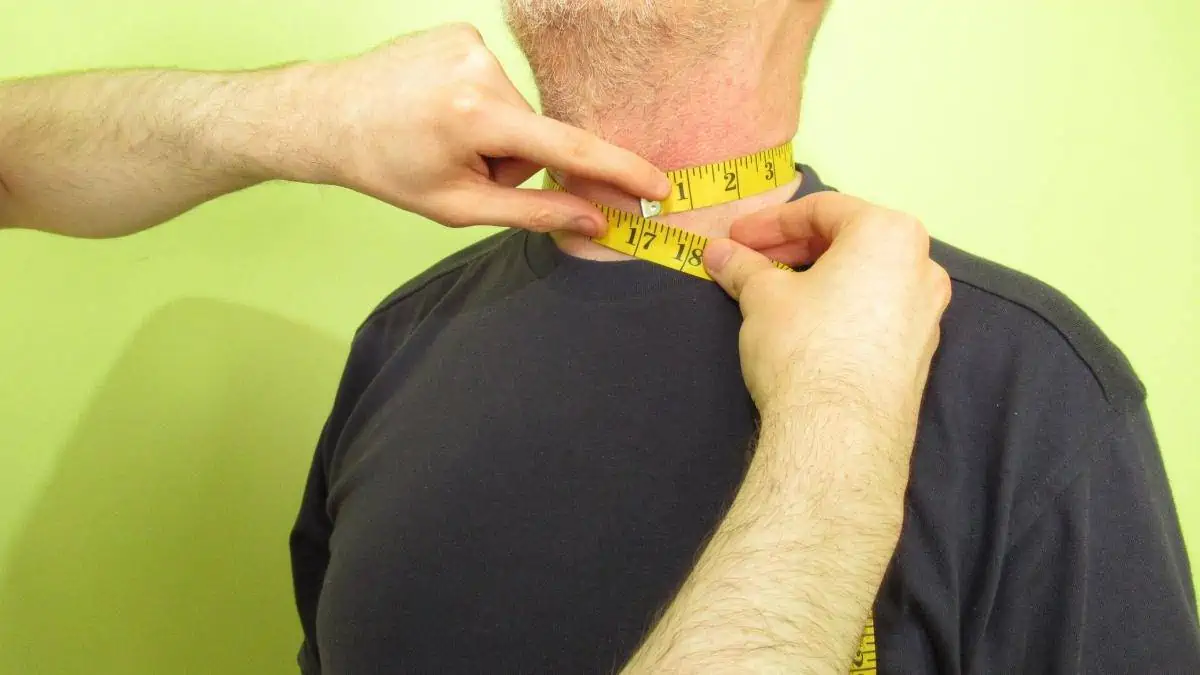This article will tell you whether a 17 inch neck is big or not and then discuss the benefits and downsides of actually having a 17” neck from both a health and aesthetic standpoint.
One thing that you should know right away is this: A 17 inch neck is well above the average male neck size. But whether or not having a 17 in neck is bad or not mainly comes down to your body fat level. More on that in a minute.
Compare Your Neck:
What does a 17 inch neck look like?
So what exactly does a 17 inch neck look like in real life? As with any body part, the primary determinant of what a 17” neck looks like is your body fat level, specifically the ratio of muscle mass to fat tissue around your neck.
If your sternocleidomastoid muscles are bulging out of your neck, then obviously, your 17 inch neck will look very muscular and, in many people’s eyes, very aesthetically pleasing as well.
On the other hand, if you have a 17” neck due to being overweight or obese, then your neck won’t look as aesthetic or imposing because it’ll naturally consist of more muscle mass than fat tissue.
While this is definitely true for a man’s neck, the same holds true for a woman’s neck—it’s just that few women have a lean and muscular 17 inch neck. So if you have a 17 in neck as a female, then it could be a strong sign that you’re obese.
Is a 17 inch neck big?

Is a 17 inch neck big or not? Yes, a 17 inch neck is definitely big. In fact, a 17” neck is around 2 inches bigger than average for a man. So if you have a 17 in neck, then you definitely have a lot of muscle mass (or fat tissue) on your neck.
A 17 inch neck is still pretty large, even for those who train their necks directly with flexions and extensions. After all, few people can sculpt a lean 17” neck by just doing heavy compound exercises—getting a seriously big neck usually requires direct training.
Now, if you’re really into neck training and stay consistent with your workouts for many years, then there’s a good chance that you could actually surpass your 17 inch neck circumference.
The neck really does seem to have a lot of growth potential, meaning that, providing they’re willing to put in the time and effort, few people will be doomed to have a pencil neck for the rest of their life.
How big is a 17.5 inch neck?

A 17.5 inch neck is definitely on the large side. The only people who have a 17.5” neck are those who train their neck muscles with weights and those who have lots of excess body fat.
If you have a 17.5 inch neck that primarily consists of muscle mass, then people might well comment that you have a really big neck. After all, if you had arms of an equivalent size, then people would definitely take notice!
Of course, having a 17.5 inch neck or even just a 17 inch neck isn’t universally good. Some medical sources note that having a 17 inch neck increases your risk of developing obstructive sleep apnea. [1]
However, the same source says that having a 17 inch neck is an indicator of having too much fat around your neck, which obviously isn’t the case if your neck is lean and muscular.
What size is a 17 inch neck?

A 17 inch neck is equal to a size extra-large (size XL) in most clothing brands that I’ve come across. In some cases, a 17 inch neck measurement will be equal to a size large or may lie between large and XL.
Just note that when you’re shopping for shirts, you typically want to choose a collar size that’s half an inch to an inch bigger than your actual neck size. This is so that the collar isn’t too tight around your neck—you want to be able to breathe comfortably when you’re wearing a shirt.
How to get a 17 inch neck for bodybuilding
Having a 17 inch neck due to obesity and building a 17 inch neck for bodybuilding are two very different things. With that in mind, this guide will discuss the best strategies for sculpting a 17” neck for aesthetic and physique enhancement purposes.
Serious neck training

Although a few genetically gifted individuals might be able to get a 17 inch neck by just deadlifting, this isn’t the case for most people. And besides, regardless of your genetics, heavy compounds definitely are not the most efficient way to grow your neck.
For most people, noticeable neck gains require direct neck training. But you need to be consistent. It’s better to do a few weekly sets consistently (which is all your neck needs to begin with) than to train it every day for a month and then quit neck training altogether.
Basic neck curls and neck extensions will build most of your size. But you may also want to add in some side neck raises to give the all-important sternocleidomastoid some extra stimulation.
As for sets, 2-3 sets of each exercise twice per week is a good place to start. You can definitely do more sets as and when required, but you really don’t need much volume to get the initial neck gains rolling in.
Your form and willingness to increase the resistance are more important than doing endless sets and training to failure, especially for the neck.
Eat in a calorie surplus

The best way to secure your neck gains—now and in the future—is to eat in a calorie surplus. This will ensure that your muscles have the energy and nutrients that they need to perform well and grow bigger.
Additionally, gaining body weight usually results in girth increases all over your body. After all, the new weight has to go somewhere!
And if you’re training your neck with weights, then some of your new muscle mass is bound to go to your neck, so you definitely want to slowly increase your body weight over the months if you’re looking to maximize your neck development.
Train your neck from multiple angles

As mentioned, a 17 inch neck is pretty big. And although you can definitely sculpt a 17” neck with nothing other than neck flexions and extensions, doing other exercises as well can definitely speed up your progress.
For example, side raises are an excellent exercise for working each side of your sternocleidomastoid independently. They’re also useful for just generally giving your neck muscles more training volume.
If you have a neck harness, then you can also do banded neck curl and extension variations to work your neck muscles from a different angle. For example, on one day, you could do heavier neck exercises with free weights, and on a different day of the week, you could do some lighter neck training with bands.
Is it bad to have a 17” neck?

Most research on sleep apnea considers 17 inches to be a large neck for males. [2] And while it’s true that most people with a 17 inch neck in the general population have excess body fat, there’s no guarantee that you can keep growing your neck while maintaining a low risk for developing sleep apnea.
There are many professional bodybuilders and strength athletes who have sleep apnea, and these folks definitely have necks in excess of 17 inches.
Having a large neck circumference is one risk factor for sleep apnea, as is tonsil size, tongue size, obesity, and snoring. [3]
Unfortunately, there are too few people with lean 17” necks to say whether this specific neck measurement is going to significantly increase your risk of developing sleep apnea. It would be very interesting to see a study of people with large and muscular necks to see how their neck size affects their health.
The verdict on building a 17 in neck

Building a lean 17 inch neck is likely to take you 6 months at a minimum and likely much longer if your starting point is skinny. The neck does grow fast, but this is because it’s a relatively untrained muscle for most people.
Once you start gaining some size, however, your growth rate will begin to slow down significantly. At that point, you can either decide to maintain your current size or keep striving for a bigger neck.
Additionally, while having a 17” neck can definitely improve your physique, you don’t need a neck that big to look strong and muscular.
References
- Torborg, L. (2015, December 9). Mayo Clinic Q and A: Neck size one risk factor for obstructive sleep apnea. Mayo Clinic News Network. https://newsnetwork.mayoclinic.org/discussion/mayo-clinic-q-and-a-neck-size-one-risk-factor-for-obstructive-sleep-apnea/
- Slowik JM, Collen JF. Obstructive Sleep Apnea. [Updated 2022 Feb 10]. In: StatPearls [Internet]. Treasure Island (FL): StatPearls Publishing; 2022 Jan-. Available from: https://www.ncbi.nlm.nih.gov/books/NBK459252/

